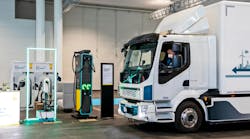Laying Rubber
Okay, I admit, I was a little disappointed with the "ride 'n' drive" event I attended last week in Joliet, IL. I had been invited by the folks at Meritor WABCO to see a demonstration of their latest safety systems, including Electronic Stability Control, Roll Stability Control, Roll Stability Support, and the OnGuard (TM) Collision Safety System with adaptive cruise control, and the demo was to take place at the Route 66 Drag Strip--how cool is that? Well, it turns out that demo didn't actually take place on the drag strip itself, but in the parking lot adjacent to the strip. But the disappointment was fleeting, because once I got into the demo trucks to experience Meritor WABCO's systems first-hand, I was greatly impressed. First came a ride in a truck with the full complement of tractor and trailer stability control systems, and it was amazing... The company driver took a tractor-trailer up to about 40 mph and took us through first an emergency lane-change maneuver and then an offramp J-turn maneuver, to show us how well the truck would behave. Now, 40 mph isn't very fast, but it's not hard to imagine how dangerous a Class-8 truck and trailer can be if they go out of control even at that speed. In fact, at first the driver took us through the maneuvers with the systems off, and the trailer outriggers were the only things keeping the rig on its feet. But the next time around, with the safety systems on, they activated in time to decelerate the vehicle and keep it stable... The systems cut in at the last possible moment, so as to give the driver every chance to make corrections him or herself, but once they activate they keep that truck pinned to the pavement like nobody's business. Next up was the OnGuard system with adaptive cruise control. Imagine bearing down on a vehicle in a Class-8 rig, and having to react when that lead vehicle suddenly decelerates, or stops. With this new system, the truck maintained a safe distance behind the vehicle, and ground to a safe, stable stop when the lead vehicle made an emergency stop. Once again, the system cut in at the last moment, but when it did it left no doubt as to who--or in the case, what--was in charge. Does this technology have a place in every heavy-duty fleet? Of course not. But for over-the-road fleets that can benefit from reduced collision losses, this type of system seems to be a no-brainer. Hats off to Meritor WABCO for bringing this technology to market, and for making the highway safer for all of us. But next time, how about just one run down the quarter mile?
Sponsored Recommendations
Sign up for FleetMaintenance eNewsletters


